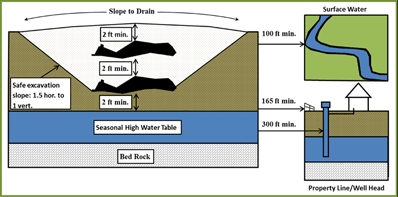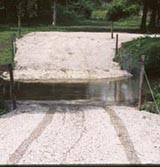Disposing of Animal Mortalities
Burying Large Animal Mortalities
State regulations (Rules of the Department of Environment and Conservation, 1200-1-7) and most local ordinances allow on-farm burial of dead livestock without a permit if the dead livestock originate on the farm where burial will take place, and the area of the burial site is less than one acre when complete.
Burying large animal mortalities can be a safe, inexpensive and convenient disposal method, particularly if excavating equipment is owned and acceptable burial sites are readily available.
Site selection is critically important to protect ground and surface water from contaminating fluids that drain from and through a decomposing carcass. Thus, it is wise to locate appropriate burial sites before you need them.
For a site to be acceptable, the bottom of the burial pit should be two feet above the seasonal high water table or bedrock and allow the carcass to be covered by two feet of soil. Any area that is consistently wet or that has a shallow depth to the water table should be avoided, because the decomposing carcass may directly contaminate groundwater (soil in these areas often has a grayish, mottled appearance). Also, rocky, sandy or cherty areas should be avoided, because rainfall can rapidly penetrate the burial site and carry contaminants from the decomposing carcass into underlying groundwater.
Where deep, appropriate soils are present, it is possible to bury up to two carcasses in the same opening so long as they can separated by two feet of soil (use a safe excavation slope of 1.5H:1V). Finally, the site should be graded to shed rainfall and divert rainfall runoff.
The burial site must also be located well away from sensitive areas to further protect them as follows:
- 300 feet from wellheads (150 feet if the burial site is clearly down-gradient from the wellhead).
- 165 feet from property lines (the burial site should be discretely located).
- 100 feet from surface water (wetlands, streams and ponds).

If an acceptable burial site canít be found, consider landfilling or composting the carcass.
This information is further summarized in The University of Tennessee Extension publication W258, Burying Large Animal Mortalities.
Animal Mortality Quick Reference
- Large Animal Mortalities
- Burying Large Animals
- Composting Large Animals
- Landfilling Large Animals
- Poultry Mortality Incinerators
- Dead Poultry Composting
- Mortality Publications

